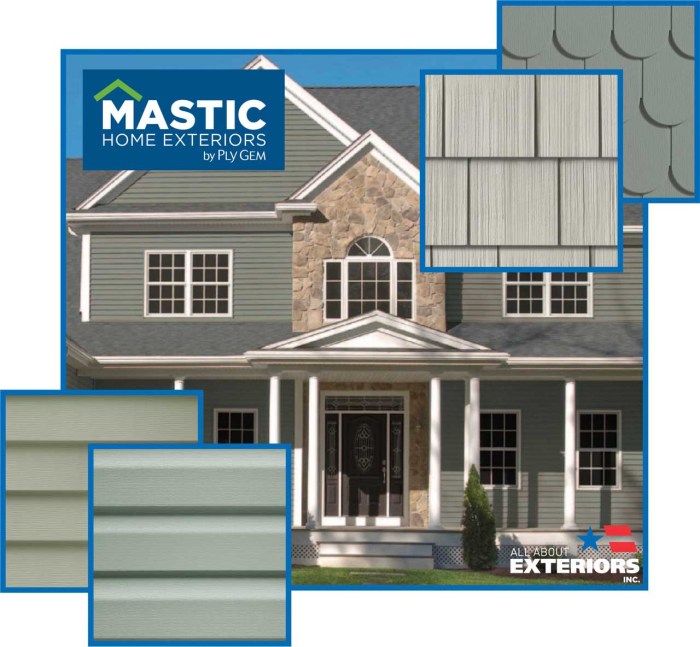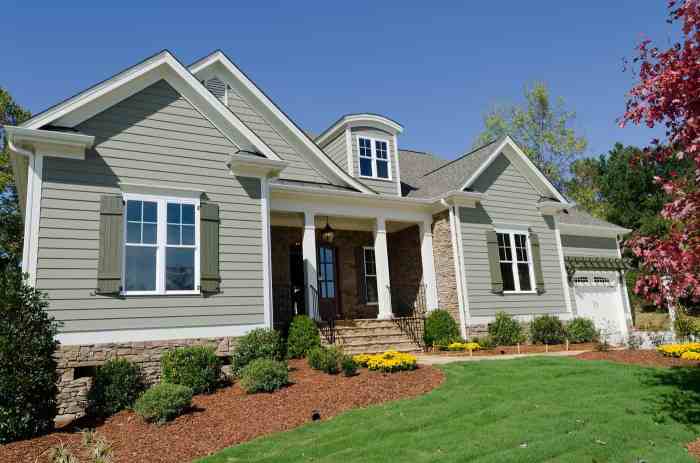Exploring the world of siding contractors near me opens up a realm of possibilities. From finding the ideal professionals to understanding the different materials available, this guide is your gateway to a successful siding project.
Delve into the intricacies of siding installation, cost estimation, and why hiring local contractors can make all the difference. Get ready to elevate your home with top-notch siding expertise.
Research on Siding Contractors
When looking to hire siding contractors, it is essential to do thorough research to ensure you are getting the best professionals for the job. Here are some key qualities to look for and tips on finding reputable siding contractors in your area.
Top Qualities to Look for in Siding Contractors
- Experience: Look for contractors with a proven track record of successful siding installations. Experienced professionals are more likely to deliver high-quality work.
- Reputation: Check online reviews and ask for references to gauge the reputation of the contractors. A good reputation is a strong indicator of quality service.
- Licenses and Insurance: Ensure that the contractors are properly licensed and insured to protect yourself from liability in case of accidents or damages during the installation process.
- Communication: Effective communication is key to a successful project. Choose contractors who are responsive, clear, and transparent in their communication.
Importance of Hiring Experienced Professionals for Siding Installation
Experienced professionals bring a wealth of knowledge and expertise to the table, ensuring that your siding installation is done correctly and efficiently. They can also offer valuable advice on the best materials and practices to use for your specific project, ultimately saving you time and money in the long run.
Tips on How to Find Reputable Siding Contractors in Your Area
- Ask for Recommendations: Seek recommendations from friends, family, or neighbors who have had siding work done recently.
- Research Online: Look for contractors with positive reviews on reputable websites and check their ratings with the Better Business Bureau.
- Get Multiple Quotes: Obtain quotes from multiple contractors to compare prices and services offered before making a decision.
- Check for Warranties: Inquire about warranties on materials and workmanship to ensure you are protected in case of any issues down the line.
Types of Siding Materials

When it comes to choosing the right siding material for your home, there are several options available in the market. Each type of siding material has its own set of pros and cons, making it essential to consider factors like climate and budget before making a decision.
Vinyl Siding
- Pros:
- Cost-effective
- Low maintenance
- Wide range of colors and styles
- Cons:
- Can crack or fade over time
- Not as durable as other materials
- May not withstand extreme weather conditions
Wood Siding
- Pros:
- Natural beauty and warmth
- Durable and long-lasting
- Can be easily painted or stained
- Cons:
- Requires regular maintenance like painting or staining
- Prone to rot, mold, and insect damage
- Higher initial cost compared to other materials
Fiber Cement Siding
- Pros:
- Durable and resistant to fire, insects, and rot
- Low maintenance
- Available in a variety of styles that mimic wood or stucco
- Cons:
- Higher initial cost
- Heavy and may require professional installation
- Can be prone to cracking if not properly installed
Metal Siding
- Pros:
- Highly durable and long-lasting
- Resistant to fire, rot, and insects
- Environmentally friendly and recyclable
- Cons:
- Can dent or scratch easily
- May require repainting over time
- Limited color options compared to other materials
Siding Installation Process
Installing siding on your home is a crucial step in protecting it from the elements and enhancing its curb appeal. The process involves several steps that need to be followed carefully to ensure a successful installation.
Step-by-Step Process
- Prepare the surface: Before installing siding, the surface of the house needs to be properly cleaned and any old siding removed.
- Measure and cut siding: Accurate measurements need to be taken to ensure the siding fits perfectly. Use a saw to cut the siding panels to the correct size.
- Install flashing: Flashing is essential to prevent water from seeping behind the siding. It should be installed around windows, doors, and corners.
- Attach siding panels: Start at the bottom and work your way up, overlapping each panel to prevent water infiltration. Use nails or screws to secure the panels in place.
- Finish with trim: Install trim pieces around windows, doors, and corners to give the siding a polished look.
Tools and Equipment
- Siding panels
- Tape measure
- Saw
- Level
- Nails or screws
- Flashing
- Trim pieces
Common Challenges and Solutions
- Uneven surfaces: If the surface of the house is not level, shim the siding panels to ensure a smooth appearance.
- Moisture issues: Properly install flashing and ensure all seams are sealed to prevent water damage.
- Incorrect measurements: Double-check all measurements before cutting siding panels to avoid costly mistakes.
Cost Estimation for Siding Projects
When planning a siding project, it's essential to have a clear understanding of the costs involved. Several factors influence the overall cost of siding installation, including the type of siding material, the size of the project, labor costs, additional features, and any unforeseen issues that may arise during the installation process.
To help you budget effectively and avoid hidden costs, let's break down the key elements that impact the cost of siding projects.
Factors Influencing Siding Project Costs
- The Type of Siding Material: Different siding materials come at varying price points. For example, vinyl siding is typically more affordable compared to fiber cement or wood siding.
- Size of the Project: The total square footage of the area to be covered plays a significant role in determining the overall cost. Larger projects will naturally cost more than smaller ones.
- Labor Costs: The cost of labor for siding installation can vary depending on the complexity of the project and the experience level of the contractors involved.
- Additional Features: Extras such as trim work, insulation, and decorative elements can add to the overall cost of the project.
- Unforeseen Issues: Any unexpected problems that arise during the installation process, such as structural damage or the need for repairs, can impact the final cost.
Rough Estimate of Siding Installation Cost per Square Foot
On average, the cost of siding installation per square foot can range from $3 to $10, depending on the factors mentioned above.
Effective Budgeting for Siding Projects
- Get Multiple Quotes: Obtain estimates from several siding contractors to compare prices and services offered.
- Plan Ahead: Factor in all potential costs, including materials, labor, permits, and any unexpected expenses, when creating a budget.
- Consider Long-Term Value: While upfront costs are important, also think about the durability and maintenance requirements of different siding materials to ensure a cost-effective choice in the long run.
- Stay Informed: Ask questions, clarify any doubts, and make sure you have a detailed contract outlining all costs and services before starting the project to avoid surprises.
Benefits of Hiring Local Siding Contractors

When it comes to home improvement projects like siding installation, hiring local contractors can offer numerous benefits that can make a significant difference in the overall experience and outcome of the project. Local siding contractors are familiar with the area, local building codes, and weather conditions, which can result in a smoother and more efficient process.One of the key advantages of hiring local siding contractors is the personalized service they can provide.
Local contractors are often more accessible and responsive, allowing for better communication throughout the project. Whether you have questions or concerns, local contractors are typically able to address them promptly, leading to a more satisfying experience for homeowners.Additionally, local siding contractors can offer quicker response times in case of emergencies or unexpected issues that may arise during the project.
Their proximity to your location means they can easily come to the site, assess the situation, and take necessary actions promptly. This level of responsiveness can help minimize delays and ensure that the project stays on track.Furthermore, working with local contractors can provide a sense of community and trust.
Local contractors often have established relationships with suppliers, other tradespeople, and previous clients in the area. This network can be beneficial in terms of recommendations, referrals, and even potential discounts on materials or services.Overall, hiring local siding contractors can result in a more personalized, efficient, and reliable experience for homeowners, ultimately leading to successful siding projects and satisfied customers.
Testimonials of Successful Siding Projects
- Local contractor ABC Siding completed a siding project in my neighborhood and the results were outstanding. The team was professional, communicative, and the project was completed within the estimated timeline.
- I hired XYZ Siding, a local contractor, for my home siding installation and they exceeded my expectations. The attention to detail and quality of work were exceptional, and I couldn't be happier with the results.
End of Discussion

As we wrap up our journey through the realm of siding contractors near me, remember that the right choice can transform your home. With the knowledge gained here, you're equipped to make informed decisions and achieve stunning results. Your dream siding project is just a contractor away.
Detailed FAQs
How can I find the best siding contractor near me?
Research online reviews, ask for referrals, and ensure they have experience in siding installation.
What are the most popular siding materials?
Vinyl, wood, fiber cement, and metal are commonly used siding materials with their own advantages and disadvantages.
What tools are needed for siding installation?
Tools like a hammer, nails, level, tape measure, and safety gear are essential for a successful siding installation.
How much does siding installation cost per square foot?
On average, siding installation can cost between $4 to $8 per square foot, depending on the material and complexity of the project.
Why should I hire local siding contractors?
Local contractors offer personalized service, quick response times, and a better understanding of local building codes and climate conditions.









